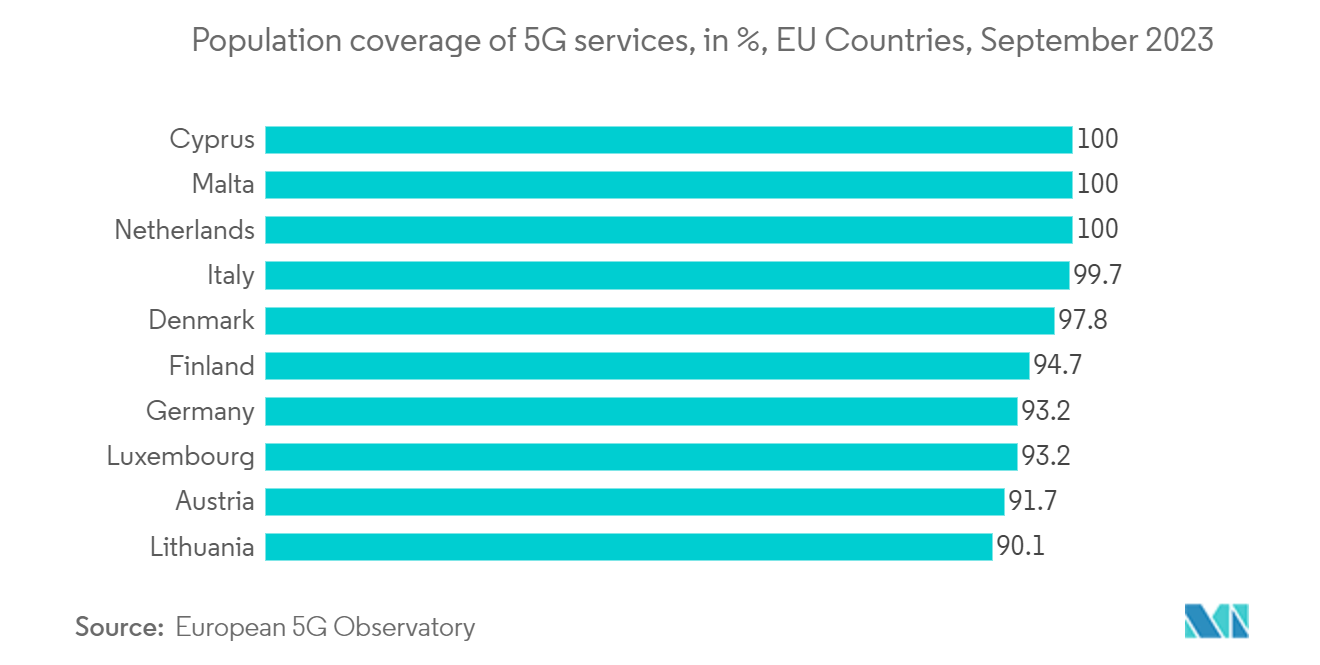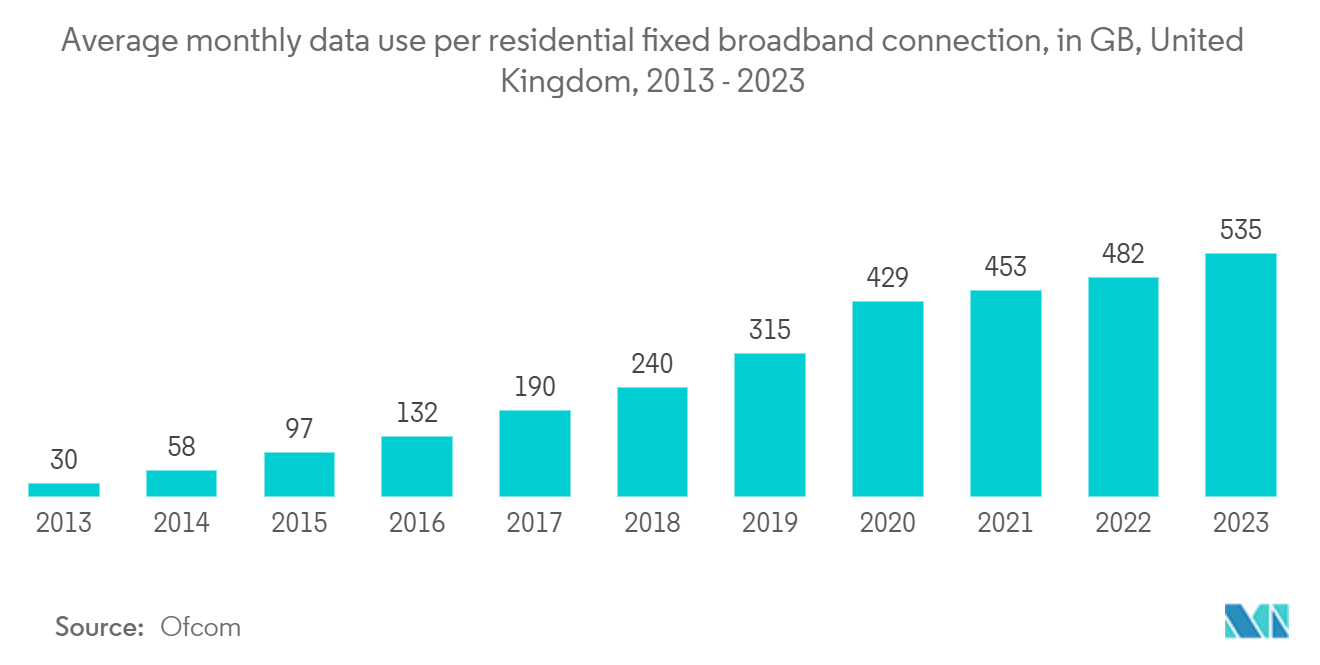Market Trends of Europe Fixed Wireless Access (FWA) Industry
Growing Demand for High-speed Data Connectivity
- Across Europe, industries such as education, healthcare, and business are increasingly demanding high-speed internet, propelling the adoption of fixed wireless access (FWA) solutions. As remote work, online learning, and content streaming become more prevalent, traditional broadband services often struggle to meet these needs, especially in rural locales. FWA emerges as a practical alternative, delivering faster and more dependable internet in areas where establishing fiber or cable infrastructure proves too costly or logistically daunting.
- The expansion of 5G networks stands out as a pivotal force behind FWA's growth in Europe. By providing speeds and latency far superior to 4G and its predecessors, 5G technology significantly boosts FWA's performance. This enhancement positions FWA as a compelling choice for both consumers and businesses in regions lacking robust traditional broadband. Owing to 5G, FWA can now match gigabit-level speeds, rivaling those of fiber-optic services.
- For instance, in July 2024, Telefónica and Nokia collaborated to introduce a private 5G solution in Spain. Under this agreement, Telefónica is expected to deploy Nokia's private networking products across diverse industries, including ports, manufacturing, and logistics. Nokia asserts that this partnership will propel Industry 4.0 in Spain's enterprise landscape, enabling sectors to harness data more effectively. Furthermore, it is expected to bolster Telefónica's network capabilities and provide a seamless transition for use cases migrating to 5G.
- As of September 2023, Cyprus, Malta, and the Netherlands achieved full 5G population coverage, as reported by the European 5G Observatory. In contrast, the average coverage across the European Union's 27 member states reached 81%. The European Union has actively implemented various initiatives to accelerate the deployment of 5G infrastructure within the bloc, setting an ambitious target of achieving complete population coverage by 2030.
- FWA's capacity to bridge the digital divide in Europe's rural and underserved areas stands out as a primary driver. High costs and logistical challenges in laying fiber cables have left many rural regions in Europe without reliable high-speed broadband. However, FWA, especially when bolstered by 5G, is emerging as a cost-effective solution for these connections. With a focus on promoting digital inclusion, both governments and telecom companies are ramping up investments in FWA to deliver high-speed internet to these remote regions.

The United Kingdom is Expected to Hold a Major Share of the Market
- Leading the charge in Europe's telecommunications innovation, the United Kingdom has seen major players like BT and Vodafone heavily invest in 5G networks. Bolstering these efforts, the UK government has championed initiatives to fast-track 5G infrastructure, a pivotal element driving the FWA technology. With the advantages of a swifter network and reduced latency, the UK FWA market stands on the brink of significant expansion. This cutting-edge telecom framework positions the country as a frontrunner in embracing FWA solutions, particularly in its often-overlooked rural and suburban locales.
- To ensure every citizen has access to high-speed internet, the UK government has rolled out multiple initiatives promoting digital inclusion. One such program, Project Gigabit, focuses on extending high-speed broadband to the nation's rural and remote areas, directly bolstering FWA's growth. Beyond financial backing, these initiatives cultivate a regulatory landscape that accelerates the rollout of fixed wireless solutions, granting the country a distinct advantage in Europe's FWA arena.
- According to Ofcom's Connected Nations spring update, as of January 2024, 62% of UK households had access to full-fiber broadband. This technology, which utilizes fiber-optic cables, offers users a faster and more reliable internet service. This represents a notable jump from 48% the previous year, underscoring the rapid rollout of full-fiber technology across the United Kingdom. The number of premises lacking decent broadband, defined by the government as download speeds of at least 10 Mbit/s and upload speeds of 1 Mbit/s, steadily decreased, dropping from 68,000 to 57,000 over the past year. Additionally, mobile coverage is on the rise, with 92% of the country receiving 5G coverage outdoors from at least one mobile network operator, a significant increase from 82% just a year ago.
- In the United Kingdom, a considerable proportion of the population lives in rural or semi-urban locales, often facing challenges with traditional broadband services, which can be either inaccessible or inconsistent. Fixed wireless access (FWA) is a budget-friendly solution, enabling the delivery of high-speed internet to these regions, all without the extensive investments typically required for fiber-optic infrastructure. Given the surging demand for reliable broadband in these neglected areas, the United Kingdom stands out as a prime market for FWA deployment, presenting a swift and scalable approach to narrowing the digital divide.
- Ofcom reported that in 2023, the average monthly data usage for fixed residential broadband connections in the United Kingdom hit 535 gigabytes, an increase from 482 gigabytes in 2022. This surge in broadband data traffic underscores the country's growing embrace of data-intensive activities, including 4K streaming and online gaming.


